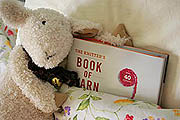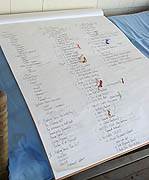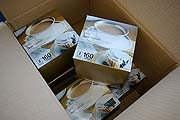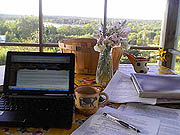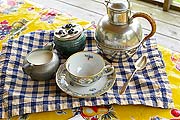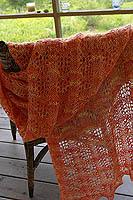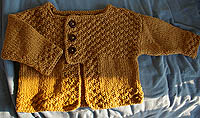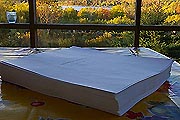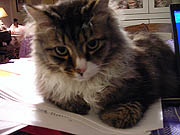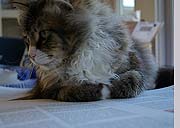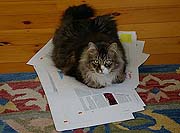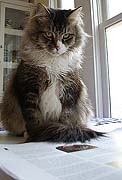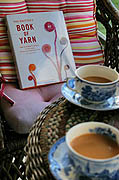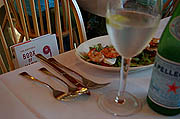Under the Covers: Writing the Knitter's Book of Yarn

Errata | Alternate photos of the projects | Clara's books
Pattern download (PDFs): Maine Morning Mitts


Once upon a time, there lived a little girl who dreamed of being a writer. She didn't know what she'd write, mind you. But she dreamed of sitting in a book-lined library at her trusty typewriter (yes, this was that long ago) tapping out page after page of gold.
Term papers and teenage angst-filled journals gave way to writing about faraway places and events, and then to technology she did not understand. She worked for years to tackle this new language and do well, but always with a heavy heart.
And then one day, as a challenge from a colleague, she changed subjects and wrote about something she did understand and deeply loved: yarn. The reaction was immediate, like that of a plant put back in its own habitat after years of struggling under the wrong conditions. She found her subject, and she knew what she'd write. That was me, and that's how I got here.
It's a Deal!
Fast-forward to a bright October day a few years ago, when I received a phone call from Rosy Ngo, an editor at Potter Craft (and now the editorial director). She asked if I'd ever thought of writing a book. I said yes, sparing her details about those childhood typewriter dreams.
I'd received a few such calls from others in the past, and all but one seemed to hinge on an unappealingly trendy topic, unrealistic deadline, nonexistent budget, and quite often a publisher with no knitting background whatsoever. I politely declined all those offers, but this time it was different.
This time, someone was asking me what book I dreamed of writing, and saying yes without any hesitation. At the end of our two-hour conversation, we had the beginnings of a deal. Not a paperback Learn to Knit in Five Seconds Flat, due three weeks from then, but a big, thoughtful, comprehensive hardcover book all about my beloved yarn.
What Is The Knitter's Book of Yarn?
Believe it or not, some people don't consider yarn a very sexy topic. Nobody had made a book like this before, and quite a few people raised their eyebrows when I told them what I was writing. "Yarn?" they'd ask, waiting for me to start laughing and tell them I was kidding. But I wasn't.
I knew that knitters were ready and eager for a book that explained yarn and all its mysteries. What the difference is between two- and three-ply yarn, why can't we felt with some white wools, what we should really make with that gorgeous skein of yarn we got at the fiber festival last year.
The book was designed around two components: tons of information about yarn, and patterns to help people practice what they'd just read. It would start with background on all the most common fibers you'd find in commercial yarn, where they come from, how they feel and wear and behave, and how they tend to be prepared.
Then I'd show the most common ways that those fibers are prepared for spinning, exactly how they're spun (with sections on the most common spin and ply types), and ultimately what they want to become. The goal was to help you pick up a skein of yarn, touch it, study it in the light, smell it, un-twist it, and understand what that yarn wants to do for you. I call it "yarn whispering."
At each juncture, a pattern would be patiently waiting. Not only would I say that woolen-spun two-ply yarn is perfect for lacework because it holds open the knitted space around it, for example, but I'd also include a lace pattern using two-ply yarn. If I said that mohair has marvelous drape and sheen, then I'd include a shawl pattern designed expressly to show off the drape and sheen in mohair. In total, the book would have 40 such patterns.
While I designed a few of the patterns myself, I also wanted the book to reflect other people's creative input as well. I reached out to friends and colleagues I admire, and they each responded with generosity and inspiration for which, to this day, I am deeply grateful.
Writing a Book: How it Really Works
The topic of yarn is about as vast as, say, a book about air or water. I had a general idea of just how far the book would go, but I needed help bringing it all together. I sought the help of my trusty friend, the giant Post-It note (available at your local Staples).
But Post-Its could only do so much. The other vital tool for my mission would be tea. Vast quantities of malty Assam tea, which I ordered directly from England. Once this box arrived, I knew I was ready to begin.
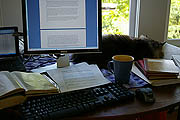
But as winter turned to spring and then to summer, I moved operations out onto the porch. And I realized that big monitors don't write books, people write books—so I abandoned the monster monitor and kept going.
My fearless designers had their marching orders and were dutifully designing and knitting away on their projects. Meanwhile, I was knee deep in research of my own—finding out how scales work, why superwash yarns tend to stretch after you knit and wash them, and how they really make chenille. I read everything I could find, talked to everybody I could, and put that all together with everything I'd learned about yarn thus far on my journey.
It was a pretty arduous period of time, but I had company.
And just when I'd spent too much time on a particular chapter, two dear friends would pick me up and whisk me out onto the ocean for a sail. Nothing refreshes the spirit like gliding across the bay, powered by nothing more than wit and wind. I'd return home relaxed, rejuvenated, and ready to tackle another topic. Yak, here I come! But not before making myself a little tea party. Because while you may work all day before realizing you're still in your pajamas, book-writing still needs comforting rituals to honor the process and lift the spirits.
And then, miracle of miracles, the designs started to arrive. It amazed me to see how a conversation with a designer about form and function, about the ideal project for the ideal yarn, became a physical object. This is Shelia January's Optic Waves Shawl, a very simple pattern designed expressly to show off the delicious mohair from Brooks Farm Fiber.
As more and more projects kept arriving, I started to realize just how big a project this was. Here we have Jennifer Hagan's Baby Soft Cardigan, designed in Blue Sky Alpaca's organic two-ply cotton—an example of the textured surface that two-ply can create, and of the suitability of organic cotton for baby gifts. Plus it's cute and extremely easy to knit.
The patterns all went to their technical editor for careful review. I crossed every "t" and dotted every "i," made sure every YO had its K2Tog, that every concept had its photograph or illustration, that those mittens in the two-ply section really were made from two-ply yarn. I became quite the bore to all those around me, forgetting that they might not be as interested in hearing about "the book" as I was interested in talking about it.
Time grew tighter, the tick-tock of the clock became an ever-present sound in my head. I did not sleep, I went through reams of paper and cartridge after cartridge of ink. I consumed boxes of tea and embarrassing quantities of dark chocolate. In the midst of it all, my house was hit by lightning, and the last week before the book was due, my site was shut down by my host and I was forced to spend the weekend moving it to a dedicated server. And briefly, very briefly, I wondered why in the world I'd said "yes" on that fateful October day so long ago.
But in the end, it all boiled down to this. On deadline day, I packed up my baby and all her belongings and sent her off to finishing school in New York.I thought that was that, but this baby kept returning home. For months afterwards, she'd show up on my doorstep in varying states of transformation. Each time I'd find something new I'd missed in the previous round, giving me chances to correct mistakes and expand on any topics that needed expanding. It was good.
Whenever the baby returned home, my crackpot in-house editor got to work as well, ruthlessly scanning every page for errors. Here he was telling me I needed a better photograph to show color pooling. (I later added one. As I said, he's good.)
More time passed, crises erupted and were calmed, and the book marched ever closer to reality—although I couldn't shake this feeling that it was all a cruel joke and that everybody was going to jump out from behind the house and yell, "Surprise!" But they didn't. At least not yet.
One late August day, quite out of the blue, there was a knock at the door. Casey and I went to see who it was. There, standing on the doorstep, was my baby all grown up. I could hardly believe my eyes.
She'd been on the road quite a while, first traveling from China to New York and finally to Maine. I invited this intimately familiar stranger inside and made her a cup of tea out on the same porch where she'd been born a year previously. She told me all about the people she'd met, showing me their pictures inside. And she explained that she could only stay a few days before heading back out into the world to make her public debut on October 16th. I felt the occasion deserved a celebration, so I took her out for a nice dinner. (She had the grilled prawns.) She may have been turned into a "real" book with page numbers and fancy fonts and gorgeous pictures and all, she may have been influenced by dozens of other people after she left me, but she was still fundamentally my baby.
